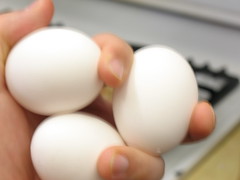 So let’s say I’m making brownies. I pull out the box, pour
So let’s say I’m making brownies. I pull out the box, pour
the mix in the bowl, add the oil and water, then crack
open the eggs and run my fingers along the inside to make sure all the egg white is out…. That last bit I don’t even think about. I've been doing it for so long that it is ingrained in my muscle memory, a reflex. I never thought about this simple action’s significance until my mom shared a story as part of a talk or testimony in sacrament meeting. I’ve forgotten the context in which it was shared, but I remember the details.This action that I had learned by echoing my mother, she had learned by echoing her mother, and my grandmother had learned by echoing her mother.
My great grandmother was raising several children during the great depression. They were poor and all lived in a one room shack. When they had an egg, or another food, they made sure to use all of it.
This policy of using all of something is not unique to my family (I think there’s something in the Boy Scout handbook about using anything you kill); it's a fairly common practice when resources are low.

The Plains Indians of North America lived off of buffalo. The hide was used as clothing or for shelter, in the form of tipis, the meat for food, the bones for weapons, and the list keeps going(scroll to the bottom of the page if you follow this). It was their life-force and they took what the needed and used every part of the body.
This type of folk knowledge is first acquired out of necessity, but bits and parts can linger long after the initial need has passed. Some of our odd habits have been passed down through generations, the original reasons barely remembered or completely forgotten, but the reasons are there. Ask your parents or grandparents about some of your quirky habits sometime. You might find out that they have more meaning than you thought.
Tying this to my post of food, I think family foods where recipes are passed down through the generations have something to be said about them. For example, during a quiet Sunday morning I decided to start counting the origins of my great,great,great,great grandparents (all 64 of them!). I found that I have a lot of Swedish descent, Irish and lots from Denmark. Do the recipes at our dinner table reflect that? I can tell you that chicken casseroles, meatloaf and potatoes are a common item on the dinner table. Is there a connection?
ReplyDeleteI think the US is too much of a melting pot to really be sure. I ate a lot of stir fries growing up, but I'm definitely not Chinese. On the other hand, my grandmother has a recipe for potato roles that has been passed through several and could have originated in Europe, but my lineage is based in so many different countries that pinpointing one would be difficult.
ReplyDeleteRecipes can also change as a result of the staples available, so the meal we eat today may be very different from what our ancestors ate.
I think that the existence of a connection depends on a family's cooking habits. My family hardly ever follows a recipe, so, if there is a connection, it came form one generation mimicking the cooking strategies of the previous generation, and not by following a treasured recipe.
Although my family has not developed quirky habits of food preparation in order to make the best use of our resources, we do have certain family recipes that my grandparents, great grandparents, and their friends invented during the depression that made the most use out of what foods were available. Many of the cassaroles my mother would make for dinner were these recipes. One such cassarole is called Mary's cassarole. I have yet to learn who Mary is, but I do know the cassarole she invented has become one of my family's favorite meals. Your post has inspired me to find out who Mary was and why she created the cassarole I love and will teach my children to make one day.
ReplyDeleteI like the details you included about the bushmen. I find the concept of using every scrap fascinating.
ReplyDeleteRecently, I noticed how peculiar it is to my family to wipe and scrape nearly every evidence of food off our plates. It took a while to find the source of this tradition, but I finally figured out it was my oldest sister who started it, and that the rest of us just followed her example. I still find it strange when others turn their plate in with puddles of gravy, bits of chicken, or other scraps of food all over it. Whether it's a feast or a famine, I always find myself cleaning my plate completely.
I find myself cringing at the thought of making my children clear their plates. I don't clear my plate all the time--I don't want to eat more than my body needs. (But do children know how to tell that? Would they rather play than eat? I don't have children, so I don't know. I guess this is something I'd like to help them learn.)
ReplyDeleteCatherine -- good post, and good comment also about how available staples can change things. Folk knowledge about food can come and go as the actual food staples do. I looked up the book that you referred to about the bushmen. Very interesting study. Next time try to put a link to it. Just going over the Amazon.com preview was helpful.
ReplyDelete